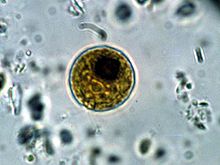- Chlamydomonas
-
Chlamydomonas 
SEM image of flagellated Chlamydomonas (10000×) Scientific classification Kingdom: Protista Division: Chlorophyta Class: Chlorophyceae Order: Volvocales Family: Chlamydomonadaceae Genus: Chlamydomonas
Ehrenb.Species See text
Chlamydomonas is a genus of green alga. They are unicellular flagellates. Chlamydomonas is used as a model organism for molecular biology, especially studies of flagellar motility and chloroplast dynamics, biogenesis, and genetics. One of the many striking features of Chlamydomonas is that it contains ion channels that are directly activated by light, such as channelrhodopsin. Some regulatory systems of Chlamydomonas are more complex than their homologs in Gymnosperms, with evolutionary related regulatory proteins being larger and containing additional domains [1].
Drawings of Chlamydomonas caudata Wille.[2]
Contents
Species
- Chlamydomonas reinhardtii [3]
- Chlamydomonas caudata Wille
- Chlamydomonas moewusii
- Chlamydomonas nivalis
Nutrition
Most species are obligate phototrophs but C. reinhardtii and C. dysosmos are facultative heterotrophs that can grow in the dark in the presence of acetate as a carbon source.
Morphology
- Motile unicellular alga.
- Generally oval in shape.
- Cellulosic Cell wall.
- Two anteriorly inserted whiplash flagella. Flagella originates from a basal granule located in the anterior papillate or non-papillate region of the cytoplasm. Flagellum shows typical 9+2 arrangement of the component fibrils.
- Contractile vacuoles found at near the bases of flagella.
- Prominent cup or bowl shaped chloroplast is present. The chloroplast contains bands composed of a variable number of the photosynthetic thylakoids which are not organised into grana-like structures.
- Pyrenoid with starch sheath is present in the posterior end of the chloroplast.
- Eye spot present in the anterior portion of the chloroplast. It consists of two or three, more or less parallel rows of linearly arranged fat droplets.
References
- ^ A Falciatore, L Merendino, F Barneche, M Ceol, R Meskauskiene, K Apel, JD Rochaix (2005). The FLP proteins act as regulators of chlorophyll synthesis in response to light and plastid signals in Chlamydomonas. Genes & Dev, 19:176-187 [1]
- ^ Hazen, Tracy E. 1922. The phylogeny of the genus Brachiomonas. Bulletin of the Torrey Botanical Club. 49(4):75-92, with two plates.
- ^ Aoyama, H., Kuroiwa, T and Nakamura,S. 2009. The dynamic behaviour of mitochrandia in living zygotes during maturation and meiosis in Chlamydomonas reinhardtii. Eur. J. Phycol. 44: 497 - 507
External links
- Chlamydomonas Center
- Chlamydomonas reinhardtii Transcription Factor Database
- "Chlamydomonas"; a song by Andy Offutt Irwin about the life cycle of Chlamydomonas; posted on the website of the International Society of Protozoologists
Categories:- Green algae
- Chlorophyceae stubs
Wikimedia Foundation. 2010.


